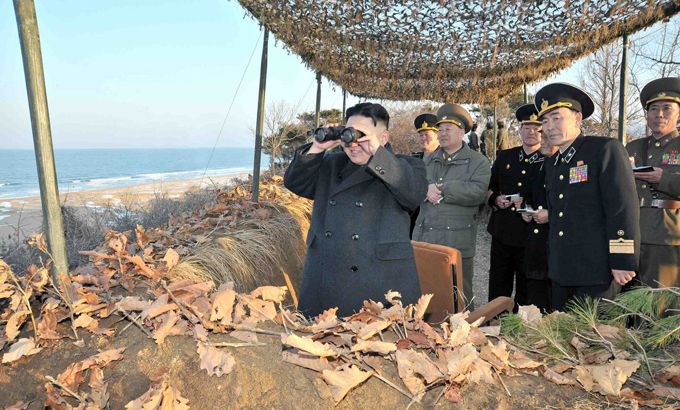N Korea ‘readies’ rockets to strike US bases
Kim Jong-un gives order and blasts Washington with angry rhetoric after US stealth bombers flown over South Korea.

North Korea’s leader has responded to America’s use of nuclear-capable B-2 bombers in joint South Korean military
drills with more angry rhetoric, saying his rocket forces are ready to attack US positions.
The North’s official Korean Central News Agency (KCNA) news agency said on Friday that Kim signed off on the orders at a midnight meeting of top generals and “judged the time has come to settle accounts with the US imperialists in view of the prevailing situation”.
Keep reading
list of 4 itemsAfter the Hurricane
World’s coral reefs face global bleaching crisis
Why is Germany maintaining economic ties with China?
In the event of any “reckless” US provocation, North Korean forces should “mercilessly strike the US mainland… military bases in the Pacific, including Hawaii and Guam, and those in South Korea”, he was quoted as saying.
South Korea’s Yonhap news agency reported on Friday that increased activities involving vehicles and troops at North Korea’s mid- and long-range missile units were detected by the South’s military.
“There is a combat duty readiness in effect at the North’s missile units since February 26 so there is a possibility they will actually fire,” the agency quoted a military official as saying.
‘Intense rhetoric’
With tensions soaring on the Korean peninsula, two B-2s flew training bombing runs over South Korea on Thursday to underline US commitment to its military alliance with Seoul in the event of any aggression from the North.
Kim argued that the stealth bomber flights went beyond a simple demonstration of force and amounted to a US “ultimatum that they will ignite a nuclear war at any cost”.
Present at the emergency meeting were the Korean People’s Army (KPA) chief of general staff, director of operations and commander of strategic rocket operations.
Al Jazeera’s Harry Fawcett, reporting from Seoul, said this was not the first time this sort of threat had been made.
“The question is whether this intense rhetoric signals some kind of change, whether there is some kind of pressure on Kim Jong-un’s young leadership, whether he may be trying to shore up his position,” he said.
The US flight came as part of annual drills between Washington and South Korea, which North Korea each year denounces as rehearsals for war.
Pyongyang has been particularly vocal this time, angered by UN sanctions imposed after its long-range rocket launch in December and the third nuclear test it carried out last month.
Pyongyang ‘provocations’
The KPA had already put its strategic units at combat-ready status on Tuesday, and the following day it cut the last remaining military hotline with South Korea.
The bulk of the threats emanating from Pyongyang have been dismissed as bluster, and North Korea has no proven missile capability to strike the US mainland, or indeed Guam or Hawaii.
The US has said that the decision to send the B-2 bombers was part of normal exercises and not intended to provoke a reaction from North.
North Korea’s belligerent tones and actions in recent weeks have increased the danger in the region, “and we
have to understand that reality”, Chuck Hagel, the US defence secretary, said.
“We will be prepared, we have to be prepared, to deal with any eventuality,” Hagel told reporters at the Pentagon. “We must make clear that these provocations by the North are taken by us very seriously and we’ll respond to that.”
Sergei Lavrov, the Russian foreign minister, responded to the threat by saying that the US should refrain from undertaking “unilateral actions against North Korea” that go beyond those called for by the UN Security Council.
“We can simply see the situation getting out of control, it would spiral down into a vicious circle,” he told reporters in Moscow.
China, North Korea’s main regional ally and biggest trading partner, meanwhile, called for an easing of tensions in the region, saying that upholding peace and stability in northeast Asia “serves the common interests of all parties”, according to a foreign ministry statement.
‘Accidental war’
Jim Walsh, a former nuclear negotiator for the US in talks with North Korea, says that with tensions so high, the risk of “an accidental war” was ever-present.
Speaking to Al Jazeera on Friday, Walsh said: “The US use of those airplanes was meant to reassure South Korea, its treaty ally, and send a message back to Americans at home that we’re not going to be threatened by the North Koreans.
“I think the US is going to continue to support its ally, and we’re going to continue to have military exercises and other symbolic acts where the US is saying we support South Korea and Japan.
“The fundamentals have not changed: North Korea does not want a war; South Korea does not want a war. China and the US do not want a war. So no wants to fight a war, and that’s the good news. …
“On the other hand it’s still scary, because you can still get into an accidental war. There could be some small incident, that each side feels like it has to react to, given the current context.”